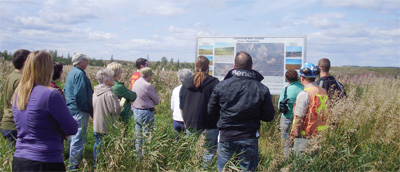
A desert-like wasteland of mine tailings two kilometres from downtown Timmins that has been converted into a green wilderness area and outdoor education centre has earned Goldcorp Inc.’s Porcupine Gold Mines the Tom Peters Memorial Mine Reclamation Award.
The 58-hectare impoundment area with tailings from the long abandoned Coniaurum Mine was severely affected by the Timmins Storm of August 31, 1961, during which an intense downpour created massive erosion channels that breached the dams and discharged tailings into the Porcupine River.Hardly any work was done on the site until 2005, when Porcupine Gold Mines initiated a three-year rehabilitation project with the assistance of AMEC.“The tailings were fairly benign,” said Richard Francoeur, Porcupine Gold Mines’ senior environmental co-ordinator. “There were no acid generating issues, no metal leaching and no arsenic. The issue we had was with the erosion gullies because every time it rained, the runoff carried tailings into the Porcupine River, causing sedimentation.”
Liability
The liability was inherited by the Porcupine Joint Venture, formed by Kinross Gold Corporation and Placer Dome in 2002 and, more recently, by Goldcorp when it emerged as the sole owner of the joint venture’s assets in September 2007.
“None of the actual rehabilitation work was ground-breaking,” said Francoeur. “We did a lot of shaping and slope stabilization to control the surface water.”
Steep banks were reshaped as gentler slopes and stabilized using rock covers. Low depression areas were filled to eliminate surface water pooling and ditches and channels were reinforced with geo-textile and rocks (rip-rap) to prevent the tailings from being carried away by runoff.
The area was covered by a thick layer of sludge from the Abitibi-Price paper mill in Iroquois Falls and seeded with wild seed mix.
Pretty standard stuff, said Francoeur, adding that it was what Porcupine Gold Mines did following the rehabilitation work that probably caught the attention of the judges and snagged the award at the fourth annual Ontario Mine Reclamation Symposium, held concurrently with the Sudbury Mining and Environment International Conference June 27th.
In 2008, 10 hives of honeybees were established on the site to promote pollination. Porcupine Gold Mines subsequently partnered with a local apiculturist and uses its share of the honey produced as gifts for visitors.
The successful revegetation has re-introduced native grass and shrub species, and attracted wildlife back to the site, including several black bears.
Educational visits
Porcupine Gold Mines went one step further by hosting educational visits to the site as part of a mine tour organized in association with the Timmins Chamber of Commerce. Since 2008, more than 150 tourists a year have toured the Coniaurum tailings site, where a series of four-foot by eight-foot story boards provide an overview of the rehabilitation work carried out by the company.
A teepee has also been erected on the site to serve as a retreat for Aboriginal youth who want to re-connect with their heritage and participate in traditional ceremonies.
The Tom Peters Memorial Mine Rehabilitation Award was established in 2008 by the Ontario Mining Association in cooperation with the Ontario Chapter of the Canadian Land Reclamation Association and the Ministry of Northern Development, Mines and Forestry with financial assistance from Vale.
The award recognizes and promotes outstanding achievements in mine reclamation and serves as a memorial to Tom Peters, an Inco agronomist who led the company’s tailings revegetation and land reclamation programs.
The rehabilitation of the Coniaurum tailings site cost Porcupine Gold Mines approximately $9 million.
According to Francoeur, the company has in excess of 30 sites that will need to be rehabilitated at some point in the future and is currently in the third year of a much more complex rehabilitation program targeting the historic Hollinger tailings.


